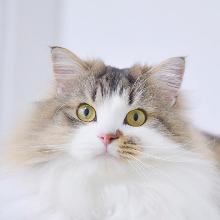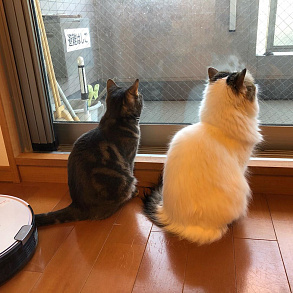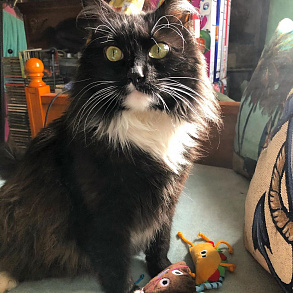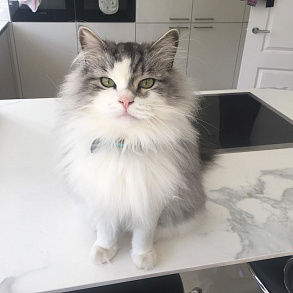Ragamuffin

Ragamuffin is the closest relative of ragdoll, who successfully combined the genes of mongrel cats and Persians. The breed is relatively young and has been taking part in exhibitions since 1994.
Brief information
- Breed name: Ragamuffin
- Country of Origin: USA
- The time of the birth of the breed: 1994
- Weight: cats 5-7.5 kg, cats 5-10 kg
- Life expectancy: 11-15 years
Highlights
- Ragamuffin translates from English as "ragamuffin". It is believed that the animals got this name because of their ancestors - mongrel cats, which were crossed with ragdolls.
- The physical development of representatives of this breed ends by 4-4.5 years.
- Ragamuffins, like Maine Coons, are heavyweight cats capable of overcoming the bar of 9-10 kg.
- The breed is non-confrontational and has fantastic patience with children and pets.
- The main problem of ragamuffins is their tendency to obesity. With an improperly compiled diet, representatives of this family quickly turn into plus-size cats.
- Ragamuffins are pampered and comfort–dependent creatures. They are alien to such truly feline qualities as arrogance, independence, the ability to stand up for their own interests.
- The breed has an extensive palette of colors, but not all of them are equally common. For example, white ragamuffins are quite rare.
- Kittens and adults are not adapted to prolonged loneliness, so leaving a pet in an empty house is cruel and unsafe for his psyche.
- Because of the unusually mild nature of American breeders, ragamuffins are called sweetmuffins (from the English sweet - sweet, muffin – cupcake) and Teddy bears in cat form.
- It is quite difficult to find a purebred ragamuffin in Russia because of the impressive price tag and the difficulties associated with importing animals.
Ragamuffin won't catch you a mouse and cheer you up with standard cat feats. This well–fed good-natured man has a different mission - permanent contemplation of the surrounding reality, occasionally interrupted by games with a ball or a clockwork rodent. Figuratively speaking, ragamuffin is a sofa hippie, radiating a calm positive, saying goodbye to predatory instincts and soaked through with love for its own owner. Accordingly, if such a cat lives in your house, most likely, you also consider watching a blockbuster with a "fluffy hot water bottle" at your side the best discharge after a busy day.
Breed characteristics
History of the Ragamuffin breed
The prerequisite for the appearance of the breed was a scandal between the American breeder Ann Baker and a group of felinologists who did not share the rights to breeding ragdoll cats . The essence of the problem was that Mrs. Baker, who declared herself as the creator of a new breed, overdid total control. Having managed to register the rights to the trademark "ragdoll" first, the woman set a bunch of restrictions for the rest of the breeders. In particular, the owners of fluffy purrs were strictly forbidden to show independence in breeding matters, as well as to register their litters in any feline systems, except IRCA.
In 1994, there was a split among the "ragdoll lovers". A group of breeders, tired of the pressure of the ubiquitous Ann Baker, decided to withdraw from the IRCA. But since in this situation the rebels lost the right to name their pets ragdolls , kotofeyam came up with an alternative name. So there was an unrecognized cat branch – ragduffin, whose representatives were later renamed ragamuffins. Moreover, the owners of purr did not stop at changing the name. Within the shortest possible time, a large-scale work was carried out to update the breed, during which ex-ragdolls were crossed with Himalayans, Persians and mongrel cats. The offspring obtained from such "marriages" became the first real ragamuffins.
Important: The path to recognition for the breed still continues, despite the fact that UFO, CFA and ACFA considered ragamuffins worthy of the right to independence and separate from ragdolls standard.
Ragamuffin's appearance
Despite the presence of the genes of Persian muroks and street cats, the appearance of ragamuffins almost does not differ from ragdolls . In particular, the standard characterizes them as heavy, bony pets with an emphatically affectionate look and rabbit fur. "Girls"-ragamuffins are always smaller than "boys", but they are also far from ballerinas. The average weight of an adult cat is 5-7.5 kg, a cat is from 5 to 10 kg. Another feature of the breed is the increased amount of fat in the abdominal area, which gives the purr body a pleasant softness and roundness.
Head
Wedge-shaped wide heads of ragamuffins are distinguished by soft, slightly convex contours. The cat's muzzle is short, oval, with a small but strong chin, which becomes more massive as the animal grows older. The pads of the vibrissae of the representatives of this breed are voluminous, the cheeks are well filled, slightly plump. The transition from the forehead to the muzzle is accompanied by a noticeable deflection, clearly visible in profile.
Neck
Ragamuffins are cats with short strong necks that become thicker and more muscular with age. This feature is more pronounced in cats than in cats.
Ears
Representatives of this breed have small proportional ears, placed under a slight forward tilt. The ear blade itself is moderately pubescent and slightly expanded in the lower part.
Eyes
Large, wide-set eyes of ragamuffins should have an intense color of the iris. At the same time, eyes of all shades are acceptable, including heterochromia. The exception to the rule is individuals of the mink and sepia colors. The iris of such cats should be blue (mink) or vary from yellow to golden and green shades (sepia). The look is naively friendly, open.
Housing
Ragamuffin's body is compact, medium-sized, with a well-palpable fat layer in the lower abdomen. In general, the animal should give the impression of a well-fed creature (no protruding ribs and spine). The cat's chest should be rounded and wide, the back line should be smooth along the entire length.
Limbs
The legs of ragamuffins are strong, with heavy bones and large rounded paws, between the fingers of which tufts of soft wool stick out. The hind legs are usually longer than the front ones, but this does not affect the overall harmony of the appearance in any way.
Tail
Medium thickness, the tip is thinner and more elegant. The correct ragamuffin has a tail covered with light, airy hair, making it look like a plume.
Wool
All ragamuffins have medium or medium-long hair. Usually the hair around the neck and along the contour of the muzzle is longer, which is why the animal's head looks larger than it actually is. On the crown, shoulder blades and back, the hair is also quite long; on the sides and belly – a little shorter. The texture of the coat is dense, but silky and soft (the so-called rabbit fur).
Color
Theoretically, the coat color of a ragamuffin can be any, but, for example, CFA specialists always reject color-point individuals, preferring tabby and bicolor purrs. Otherwise, there are no strict selection criteria for the type of color for representatives of this breed. In particular, cats are allowed to have white spots and medallions on the chest, abdomen and back, and their size and number do not play a significant role. As for the skin on the pads of the paws and nose, there are no requirements for it. Pink, two- or three–color - any types of colors are acceptable for these areas.
Disqualifying vices
Cats of excessively painful appearance with the following developmental abnormalities are not allowed to participate in exhibitions and breeding:
- strabismus;
- polydactyly;
- defective tail shape and position;
- short coat;
- color-point color.
Character of ragamuffin
Ragamuffin is a fluffy heavyweight with an unusually light character. Suspicion, the desire for independence, pride bordering on narcissism – all this is absolutely not about him. A real ragamuffin is an impossibly kind and affectionate creature, whose favorite activity is to perch on the owner's arms and hang from them with a limp carcass, imitating an accidental fainting.
In general, the breed can be called decorative: these well-fed cats really appreciate the comfort of home and get lost in the conditions of the street, often being confused. They will not slap a presumptuous puppy with their paw and will not stand up for themselves in a cat showdown, so a stray animal has no chance of survival. The world of a cat is a house where an affectionate owner and a bowl of treats are waiting for her. Everything that is outside of it is unnecessary excesses, without which the animal can easily do without.
Ragamuffins are infinitely trusting and never compete for spheres of influence with their own kind. These phlegmatic people are also willing to tolerate children, unless, of course, they are going to torment the animal. Good-natured purrs are even ready to act as live dolls, driving around in toy trucks and flaunting with pleasure in the things that the baby puts them in.
By the way, despite the fact that ragamuffins have never treated hyperactive pets, they are not considered complete idlers either. If there is no favorite toy or something similar in the field of view of the fuzzy, he will come up with another entertainment for himself. For example, he will start running around the apartment, fleeing from an imaginary enemy, or enter into a duel with curtains.
Education and training
Ragamuffin is a balanced and slightly vulnerable cat. Keep this in mind when taking up training. Otherwise, a special approach to the members of this small clan is not required. Cousin ragdoll is extremely intelligent and has a good attitude to study. He can easily arouse interest in simple acrobatic tricks, as well as develop the habit of responding to a nickname. There are no difficulties with the operation of the tray either. These are not the stubborn people who need to explain how to use the toilet for a month, and who will try to leave smelly puddles where they like best out of harmfulness.
However, it would be too presumptuous to rely on the innate intelligence of the Ragamuffins. As a child, these imposing comrades play pranks no worse than the average barsik or murzik, except that they move a little slower. Immediately stop the crumb's attempts at annoying pranks like scratching the wallpaper, digging in the trash and swinging on the curtains. Yes, in the performance of a tiny hooligan, such fun looks funny, but imagine what housing will turn into when an eight-kilogram carcass demonstrates the same numbers four years later.
If a cunning limitless person began to climb on the shelves of a closet or a kitchen table, remove it from improvised viewing platforms, simultaneously making a suggestion in a strict tone (do not shout). Keep in mind, the mustachioed fat man jumps and lands extremely clumsily, which leads to injuries. Obedience is most effectively brought up by standard prohibitive commands ("You can't!"). If you regularly use a short sharp ban, the animal will have no choice but to learn to listen. An alternative to classical methods can also be a clicker, which Western specialists like to use so much.
Maintenance and care
Despite the reputation of a phlegmatic, if not lazy creature, ragamuffin does not hold curiosity. So if a heavyweight cat has appeared in your apartment, it is wiser to hide away cosmetics, household chemicals and garbage bags that she will try to taste. Be careful with indoor flowers and purchased bouquets – most of them are poisonous to the furry researcher. Of course, no one calls for completely abandoning crop production. Just try to place pots and vases in places where ragamuffin will not get them – this "American" is not particularly jumpy. Purrs and a variety of threads (knitting yarn, floss threads) should not come into view. It is unclear what ragamuffins see as so attractive in them, but cats eat textile fibers with a great appetite.
When arranging a corner for a pet, do not forget that beds and houses for such corpulent fuzzies are selected of appropriate dimensions. As for toys, ragamuffin considers the owner to be the favorite of them. If you are not ready to constantly entertain and carry a seven–kilogram gambler on your hands, buy him a clockwork mouse, a teaser or a couple of balls - let him entertain himself.
Useful to know: ragamuffins reach psychological and physiological maturity by the age of 4, but it is recommended to castrate and sterilize them at the age of one year.
The street for decorative and image ragamuffins is full of surprises. Moreover, in extreme situations that arise outside the home, the animal is extinguished and is not able to adequately assess the threat directed at it. Of course, a cat can be taken out to breathe, but on a harness and only in quiet places where a stray dog or an uncastrated neighbor's cat, who is at the peak of marital euphoria, will not enter.
Hygiene
It seems that a cat with such a lush fur coat is certainly sofas strewn with wool, "dreadlocks" of tangles and a bunch of additional troubles, including allergies. In fact, everything is not so gloomy. Ragamuffins do not have a full-fledged undercoat, and they shed moderately. In addition, their airy "coat" does not fall off, so that your friend does not lose his photogenicity, it is enough to comb his hair once a week.
It is better to wash these funny fatties less often (once every 4-6 months), and the choice of shampoo should be approached with great scrupulousness. Give preference to products with soft, gentle surfactants that will not have a negative effect on the hair and will not provoke dryness of the skin. Other hygiene procedures for ragamuffins include brushing teeth (once every 7 days), cutting claws and rubbing eyes with ophthalmic lotions or chamomile infusion (daily).
Feeding
Ragamuffins are still food eaters. Hence the inevitable weight gain and the gradual transformation of a cozy kitty into a heavy fat lump. To prevent this from happening, breeders recommend switching to dry food developed for individuals with reduced motor activity and slow metabolism. By the way, it is more expedient to give preference to grain-free varieties, which do not include wheat, soy and corn. The cat also needs to be provided with a bowl of filtered water, since tap water provokes salt deposition in ragamuffins.
Important: due to perfectionism in matters of cleanliness, ragamuffin often clogs the intestines with wool, swallowed during the licking of its own body. In order to speed up the exit of hair lumps from the body, veterinarians advise feeding a long-haired puke with pumpkin porridge or mashed potatoes.
With a natural diet, everything is more difficult, because it needs to be selected in such a way that the food does not work as a "fatter". Yes, ragamuffins absorb the same products as any domestic mousetraps, but they reduce the serving volume by systematically carrying out control weighings. Some professional breeders (for example, Chester County from Pennsylvania), promote a menu based on wet canned food, the caloric content of which, compared with industrial "drying", is several times lower.
Health and diseases of ragamuffins
Ragamuffins are big cats with strong immunity. If we talk about genetically determined ailments, then there are only two of them in the breed: polycystic kidney disease (inherited from the Persians) and hypertrophic cardiomyopathy. In the first case, the process is irreversible, and all that can be done with early diagnosis is to slow down its course. With HCMT, the walls of the ventricles are compacted, which results in heart failure. It is also impossible to overcome cardiomyopathy completely, but with well-structured medical treatment, there are chances to prolong the life of a pet.
How to choose a kitten
- Trust only nurseries registered with ACFA and CFA.
- Find out if the litter producers have been tested for hereditary diseases, including VLK (leukemia virus).
- Play hugging with young moustaches. If, instead of going limp in your arms, the kitten breaks out and tries to get away, this is definitely not ragamuffin.
- ragamuffin kittens are born white, changing color as they grow up, so if the seller presents snow–white newborn "cupcakes" in the photo, this does not mean that they are going to deceive you.
- The purebred American ragamuffin has a long tail. Pronounced short–tailedness is a sign that you have a little impostor in front of you.
Ragamuffin price
In Russia, ragamuffins are still an exclusive, and one that not everyone knows about. And if the same ragdoll in the vastness of the post-Soviet space, you can still find, then you will have to hunt for his relative outside the CIS. As for prices, ragamuffin from the USA will cost on average from 800 to 1200 USD. However, all these are approximate calculations, to which one way or another you will have to add the costs of the flight and the commission of the reseller (when a third party is engaged in the import of the "goods").


